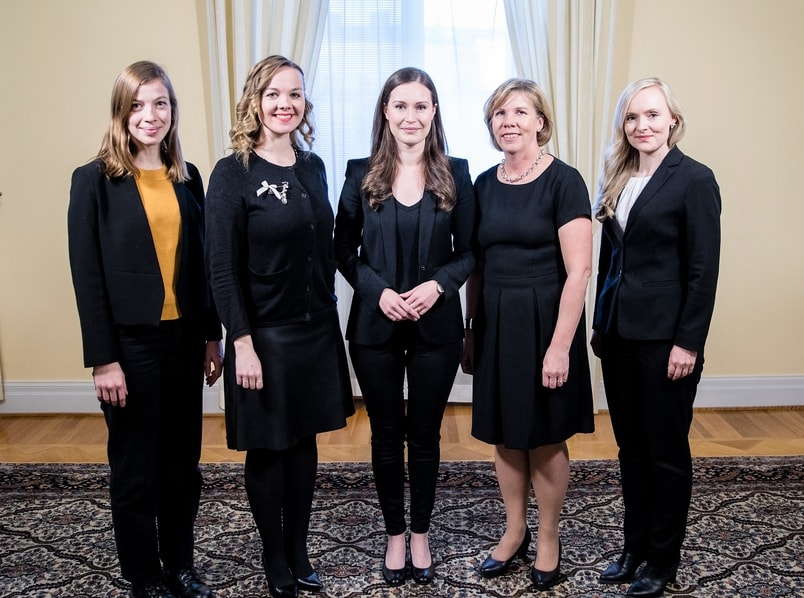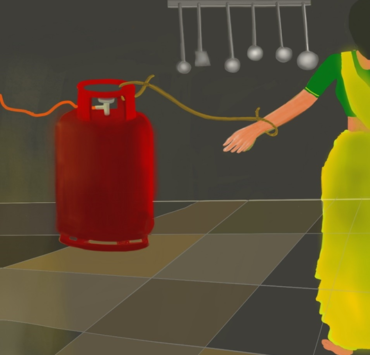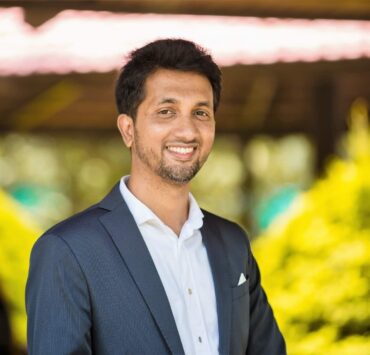YOU’VE HEARD OF FINNISH SAUNA. NOW GET READY FOR HÄN

Jazeela Sherif is an engineer turned CFO, a painter and…
Hän is more than just a Finnish word, but a contribution to the lexicon of all languages meant to set forth a cultural revision, more so on the concept of equality. It is a gender-neutral pronoun. It can mean ‘he’ or ‘she’. The word had existed even before the first printed book in Finnish in the year 1543. It was picked up from the language and presented to the world as a tested and proven approach to initiating social change.
What makes this gesture of Finland so unique is the inconsequential existence of such pronouns in many other languages not serving their purpose whatsoever. Use of the word hän is being promoted in Finland to encourage equal opportunity and inclusivity of all, irrespective of their gender, background or appearance. The hän website https://finland.fi/han/ speaks a language that may, perhaps, sound strange to our ears accustomed to gender differentiated vocabulary. This website, not only encourages us to start using the word, but through the process, aims to push the idea of ‘how mutual respect and solidarity, along with equal opportunities and decent living standards for all, lead to an inclusive society’.
The website further states that the Finnish sauna is a great equalizer that represents the non-hierarchical nature of this Nordic society. The inclusivity of the heated box of the sauna has to be experienced. There is no VIP, everyone is a hän. There are over two million saunas in Finland, in homes, offices, factories, hotels and so on. This is very Finnish, so is the concept of hän.
Gender neutrality seems irrelevant in any role unless it is carefully pushed ahead in everyday life space
Language as a part of culture has a decisive role in setting out the core values of the societies that help in promoting and supporting equality and inclusivity. Interestingly, the Finns seem to have borrowed copiously from other languages. The word hän is offered as a give-back to the rest of the world, not just as another loan-word but a solid idea to shape up gender balanced societies, and pave the way for social innovation. Finland has long been involved in promoting gender neutrality as a cultural dimension in very many ways. The outcome of the endeavor spanning over a century is a call to the rest of the world to reflect on its notions, prejudices and above all, the lack of genuine intent for a social transformation.
Publicising hän is a part of the equality program of Sanna Marin, the youngest ever prime minister of a country. She herself is a beneficiary of the welfare programs of the Finnish government, who rose to the top post in the country from very humble beginnings. Marin started off her career at the age of 27 and became the prime minister of Finland at 34. She leads a coalition government by five parties, all led by women, and four of them under thirty-five.
Finland was one of the first countries to proclaim universal suffrage way back in 1906. Isn’t it bizarre that we still have countries that are champions of equality and democracy, but haven’t yet put in power female head of state at any point in time?
Finland’s achievement is laudable in many ways when we take stock of the incidences of females coming into power through a democratic process, during the last sixty plus years. Out of the 71 countries that had female heads so far, a third were holding some sort of a temporary position as replacement, and were never elected again. In a single year, there have been only eighteen women in top positions of a country since 19601. This is a meagre 10% of the number of men who have held such posts. Surprisingly, major economies such as USA, China, Russia, and Japan are yet to join the league.
The impressive track record of Finland in promoting equality has many foundations other than the bold step in providing equal political rights to women very early in the history of democracy. The country had two elected prime ministers and a president who served a second term in the past. 47% of its parliamentarians are women and the current government has a majority of women ministers. The presence of women is also felt in top posts across a wide variety of sectors. It is also top rated in gender equality. It has been a long journey, planned well and goals chased meticulously, rather than as an outcome of haphazard reactions to demands of women activists.
The country has over 110 years of parliamentary history. The historical decision to allow universal suffrage and the right to stand for elections for all came together in 1906 with the first election after its independence. The first elected parliament had 19 women and today, it has 91, the highest so far. Twelve out of the nineteen ministers are women and Marin herself was minister of transport before.
Several early efforts by women activists helped in fostering gender equality. Finnish women activists spoke about the importance of education for girls since the 1850s. Women’s rights movement was active even before the two world wars. The first women’s organisations established in the 1880s succeeded in bringing out equal inheritance rights and right to attend university. The predominantly agrarian economy had more women who worked in the farms and later in the industries during the two world wars. Post-independence, leading social reformers worked in soft revolutionary mode along with conservatives to promote a welfare state that it is today.
Miina Sillanpää, is a key reformer who herself started as a maid, later on served as the president of the Servants Association for over 50 years, and set an example for social innovation. As a parliamentarian, she pioneered the efforts to provide social support to single women and children from extra marital affairs, working against all odds and overcoming cultural resistance to such ideas. Sustained and favorable socio-political environment for fostering equality resulted in the enactment of a series of crucial legislations. This included even simple matters like the right to keep a woman’s maiden name even after marriage. Interestingly, the spirit of equality was not missing in action at any point in time. Diversified gender equality issues were constantly put into debate.
Finland ranks third in the global gender gap index produced by the World Economic Forum (WEF), behind Iceland and Norway. The index developed by WEF considers multiple factors to evaluate the performance of countries. The WEF report says that the world may take 95 years to close the gap in political representation, which is also the worst performing dimension in the list2. Compare this with twelve years, the time to close the gap in education, pointing out the need for deliberate interventions by the governments3. The ever-growing number of women attending universities does not seem to translate into their increased political representation.
Consistent efforts of the government and the society with a clear outcome in sight, right from the days of its independence, is what makes Finland’s case stand out. Finland was a grand duchy of Russia. After independence from Russia, women and all classes of the population were allowed to stand for elections, the first country to do so in the world at a time when only 15% of its men population had voting rights. The widespread emphasis on education for all before independence helped in having lofty ideals about equal rights even before the two world wars.
The young generations in their teens had grown up seeing women presidents, prime ministers and ministers as everyday normal, resulting in children often asking if men could also become presidents. How better can such cultural constructs be driven home than by letting young people witness real life examples as they grow up? The deep imprint of stereotypical roles of women as care givers, school teachers or nurses in our perceptions are difficult to be erased from a society deeply entrenched in gendered role perceptions, and one that freezes such images in the minds of children from very early age.
In an interview Sanna Marin said she doesn’t think about her gender or age as important in performing as a prime minister. One doesn’t have to exhibit cross-gender behavior to play out the roles laden with gendered perceptions. She posted her pregnancy and breast feedings selfies and a pasta sauce recipe on Instagram, just as any normal person might have done. Her photoshoot with a fashion magazine had even stirred hot sexism debates. She likes being herself. Like any person she was also working from home during the lockdown and cared for her daughter at home.
The goal is to make gender irrelevant in any roles through careful pushing ahead of gender neutrality in everyday life space. Women leaders are the target of abuse on social and other media in a disproportionate manner. The starting point of any discussion on her is gender, and most probably, the conclusion of analysis if she fails would as well be gender. Public judgement and opponent allegations often nudge sexism making the road to a sustained political career murky. Any womanly trait will be a negative on her. If an opposition party leader in India gets addressed as the widow of her late husband, it is nothing but the epitome of aggressive sexism.
Aside such obstacles that test the perseverance of budding political careerists, what makes women stay away from politics? The answer is the absence of substantial number of women in power to create the enabling environment, one which helps in unshackling women from time consuming household and care giving duties, and getting men to share the responsibilities as well.
Finland provides a choice of subsidised childcare or homecare allowances, which is one of the most comprehensive welfare systems in the world. The allowance can be used for homecare, granny care, neighbour care or other private forms of care. Execution of the law passed in 1985 and its subsequent versions went through rough weathers during the economic recession and subsequent increase in unemployment. But it encouraged more women to be active in the labour market and politically too, as the labour situation improved later on.
In the first place, the law was pushed by different political parties to support the large number of women in employment in those days. Traditionally, women used to work in the fields in the agrarian economy of the country. Sanna Marin proposed a four-day work week to allow everyone more time with family. This is a case of both the cause and effect pushing ahead the progressive outlook on women. If the earlier women representatives were leaders of women’s organisations or women’s sections in the parties chosen by women, in later years after 1970, ministers were selected by male dominated party leaders based on political or domain experience. The equality laws made it necessary to have at least one woman to represent in political and administrative bodies.
Research indicates that women-led democratically elected bodies are favorable to advancing of mandated welfare measures for women, which includes even provision of drinking water services. Women are likely to work across party lines to champion the cause of gender equality.
Making women participation mandatory in politics through quota system is widely adopted by many countries, though Finland has used it in a different context. It has a mandatory quota for high public office jobs. It is quite a norm that most women work in jobs where more women are already employed than men. In Finland HR manager jobs are mostly held by women while very few are in IT jobs. Pay parity gap is about 18% since most paying jobs are occupied by men. This is one of the challenges for Sanna Marin in her current post. Her immediate challenges are to address the high unemployment rates, high incidences of domestic violence, achieving educational parity for children from poorer backgrounds and immigrant families, and achieving the green targets.
After her widely appreciated Corona responses and actions, her plans for 2021, include economic recovery from the pandemic, health for all, increasing global competitiveness, building infrastructure for digital transformation, green transition, improving labour market support, and service for unemployed as priorities.
As the first recipient of the ‘International Gender Equality Prize’ instituted by Finland, Angela Merkel, who also happens to be the longest serving (continuously) woman leader and as the German Chancellor, gracefully steps down this autumn, at the peak of her popularity, a political commentator had this to say:
“(She) is now on her third American and fourth French presidents, her fifth British and seventh Italian prime ministers.” Merkel was rated as the world’s most trusted leader in a survey among EU countries, way ahead of her counterparts4. With the Finland example, we are seeing more role models to look forward to, not just for women but for all, the young, old, and anyone with the right credentials.
- https://www.statista.com/statistics/1058345/countries-with-women-highest-position-executive-power-since-1960/
- World economic forum, Mind the 100 year gap, viewed 14 January 2021, https://www.weforum.org/reports/gender-gap-2020-report-100-years-pay-equality#:~:text=Drilling%20down%20into%20the%20facts,and%2021.2%25%20of%20ministerial%20positions.
- World economic forum, Key findings on Global Gender Gap Report 2020 , viewed 14 January 2021, https://reports.weforum.org/global-gender-gap-report-2020/key-findings/
- Pew Research Center, Global attitudes and trends, viewed 14 January 2021, https://www.pewresearch.org/global/2020/11/17/many-in-europe-were-confident-in-merkel-and-macron-over-the-summer-johnson-received-mixed-ratings/
What's Your Reaction?
Jazeela Sherif is an engineer turned CFO, a painter and a trained singer. Besides engineering, she holds an M.B.A, PhD, and an MSc in Financial Engineering.




